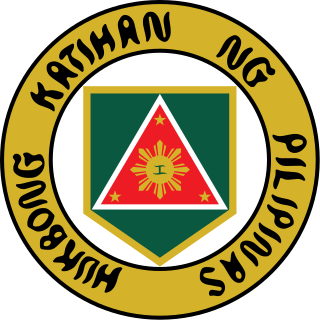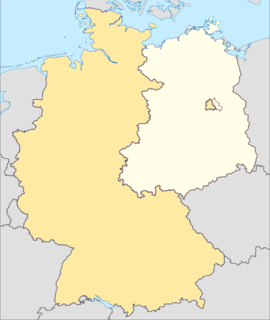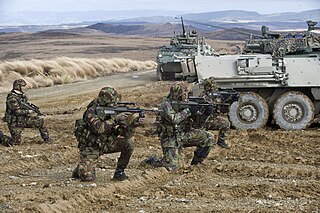
A battalion is a military unit, typically consisting of 300 to 1000 soldiers commanded by a lieutenant colonel, and subdivided into a number of companies. In some countries, battalions are exclusively infantry, while in others battalions are unit-level organizations.

The units of the British Army are commanded by the Chief of the General Staff. This is broadly similar to the structures of the Royal Navy and Royal Air Force, in that the four-star (general-equivalent) commanders-in-chief have been eliminated since 2011 and service chiefs are given direct command of their respective services and are responsible as Top Level Budget (TLB) holders. Army Headquarters is located in Andover, Hampshire. There is a Commander Field Army and a personnel and UK operations command, Home Command.

Buckley Space Force Base is a United States Space Force base in Aurora, Colorado named after United States Army Air Service First Lieutenant John Harold Buckley. Buckley was established in 1938 by the United States Army Air Corps as Demolition Bombing Range–Lowry Auxiliary Field, before being renamed Buckley Field in 1941, serving as a training base. In 1947, it became Naval Air Station Denver, serving as a reserve air station for the U.S. Navy. In 1961 it became Buckley Air National Guard Base, an gained its first space mission in 1969. In 2000, it became Buckley Air Force Base under Air Force Space Command, before assuming its current name of Buckley Space Force Base in 2021.

The brigade combat team (BCT) is the basic deployable unit of maneuver in the U.S. Army. A brigade combat team consists of one combat arms branch maneuver brigade, and its assigned support and fire units. A brigade is normally commanded by a colonel (O-6) although in some cases a brigadier general (O-7) may assume command. A brigade combat team contains combat support and combat service support units necessary to sustain its operations. BCTs contain organic artillery training and support, received from the parent division artillery (DIVARTY). There are three types of brigade combat teams: infantry, Stryker, and armored.

The Philippine Army (PA) is the main, oldest and largest branch of the Armed Forces of the Philippines (AFP), responsible for ground warfare and currently has an estimated strength of over 100,000 soldiers, backed by 120,000 ready reserves.The service branch was established on December 21, 1935 as the Philippine Commonwealth Army. The Philippine Army has engaged in many conflicts including the ongoing Communist rebellion in the Philippines and the Moro conflict, and other conflicts worldwide.

The Royal Australian Army Ordnance Corps (RAAOC) is the Corps within the Australian Army concerned with supply and administration, as well as the demolition and disposal of explosives and salvage of battle-damaged equipment. The Corps contains clerks, operator supplies, petroleum operators, parachute riggers and ammunition technicians. Members of the Corps are nicknamed Roaches.

The Illinois Army National Guard is a component of the United States Army and the United States National Guard. With the Illinois Air National Guard it forms the Illinois National Guard. National coordination of various state National Guard units are maintained through the National Guard Bureau. The Illinois Army National Guard is composed of approximately 10,000 soldiers.

The Royal Australian Corps of Transport (RACT) is a corps within the Australian Army. The RACT is ranked tenth in seniority of the corps of the Australian Army, and is the most senior logistics corps. It was formed on 1 June 1973 as an amalgamation of the Royal Australian Army Service Corps (RAASC) and Royal Australian Engineers Transportation Service. The RACT is responsible for the operation of army surface transport assets, movement control, terminal and postal services, and Army aspects of air logistic support.
8th Combat Service Support Battalion is a unit of the 5th Brigade of the Australian Army. Originally formed as 8th Brigade Administrative Support Battalion in 1995, 8 CSSB is a part-time Army (Reserve) unit with elements at the Timor Barracks at Dundas (Sydney) and the Bullecourt Barracks at Adamstown (Newcastle). At various times in the past, the unit has had elements at Erina, Taree and Pymble.
The 2nd Combat Engineer Regiment(2 CER) is an Australian Army combat engineer regiment located at Gallipoli Barracks in Brisbane, Queensland. It is part of the Australian 7th Brigade, attached to Forces Command (Australia).
In 2009, the United States and NATO International Security Assistance Force (ISAF) coalition, along with Afghan National Army forces, continued military operations against the Taliban in Afghanistan. 2009 marks the eighth year of the War in Afghanistan, which began late in 2001. And 75th ranger regiment is also in Afghanistan as of 2018

The structure of the United States Army is complex, and can be interpreted in several different ways: active/reserve, operational/administrative, and branches/functional areas.
13th Combat Sustainment Support Battalion is a modular, corps-level support organization Battalion responsible for providing multifunctional logistics support to maneuver, fires, and effects organizations as well as multifunctional logistics assistance to other support organizations. The 13th CSSB was formerly stationed at Fort Benning, Georgia, and was a subordinate unit of the 3rd Sustainment Brigade. The battalion was deactivated in October 2011 at Ft Benning and reflagged from the former 80th Ordnance Battalion at Joint Base Lewis/McChord. The battalion is now subordinate to the 593rd Expeditionary Sustainment Command.
The 7th Combat Service Support Battalion is an Australian Army administration and logistics battalion which provides transport, supply and maintenance support services to units of the 7th Brigade. The battalion is made up of both Regular personnel and has recently been involved in deployments to Timor Leste, Iraq and Afghanistan.
The 1st Brigade is currently the largest unit of the New Zealand Army, and contains most of the army's deployable units. The brigade was formed on 13 December 2011 by amalgamating the 2nd Land Force Group and 3rd Land Force Group. Its establishment formed part of the 'Army 2015' package of reforms.

The Northern Army Group (NORTHAG) was a NATO military formation comprising five Army Corps from five NATO member nations. During the Cold War NORTHAG was NATO's forward defence in the Northern half of the Federal Republic of Germany (FRG). The Southern half of the Federal Republic of Germany was to be defended by the four Army Corps of NATO's Central Army Group (CENTAG). During wartime NORTHAG would command four frontline corps and one reserve corps. Air support was provided by Second Allied Tactical Air Force.

This article describes the current structure of the New Zealand Army. It includes the army's order of battle and the headquarters locations of major units.
The term combat service support is utilized by numerous military organizations throughout the world to describe entities that provide direct and indirect sustainment services to the groups that engage in combat.
9th Combat Service Support Battalion is a unit of the 9th Brigade of the Australian Army. Originally formed as 9th Brigade Administrative Support Battalion, 9 CSSB is a part-time Army (Reserve) unit. The unit is based at Warradale Barracks Adelaide as well as a small sub-unit in Tasmania.
142nd Combat Sustainment Support Battalion is a multifunctional logistics headquarters. It is task organized as a Division Sustainment Support Battalion with capability required to support specified mission requirements. The CSSB supports echelon above brigade units, multifunctional brigades, functional support brigades, and brigade combat teams. The CSSB may support Army special operations forces as part of their area support task. The 142nd CSSB is currently stationed at Fort Bliss, Texas, and is a subordinate unit of the 15th Sustainment Brigade.










